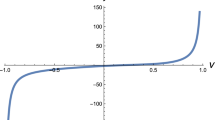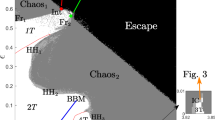Abstract
The delay differential equation, \(\dot x\)(t)=−μx(t)+f(x(t−1)), with μ>0 and a real function f satisfying f(0)=0 and f′>0 models a system governed by delayed positive feedback and instantaneous damping. Recently the geometric, topological, and dynamical properties of a three-dimensional compact invariant set were described in the phase space C=C([−1, 0], ℝ) of initial data for solutions of the equation. In this paper, for a set of μ and f which include examples from neural network theory, we show that this three-dimensional set is the global attractor, i.e., the compact invariant set which attracts all bounded subsets of C. The proof involves, among others, results on uniqueness and absence of periodic orbits.
Similar content being viewed by others
REFERENCES
Arino, O. (1993). A note on “The Discrete Lyapunov Function....” J. Diff. Eq. 104, 169-181.
Cao, Y. (1990). The discrete Lyapunov function for scalar delay differential equations. J. Diff. Eq. 87, 365-390.
Cao, Y. (1996). Uniqueness of periodic solution for differential delay equations. J. Diff. Eq. 128, 46-57.
Diekmann, O., van Gils, S. A., Verduyn Lunel, S. M., and Walther, H.-O. (1995). Delay Equations, Functional-, Complex-, and Nonlinear Analysis, Springer-Verlag, New York.
Hale, J. K. (1988). Asymptotic Behavior of Dissipative Systems, Am. Math. Soc., Providence, RI.
Hale, J. K., and Verduyn Lunel, S. M. (1993). Introduction to Functional Differential Equations, Springer-Verlag, New York.
Herz, A. V. M. (1994). Global analysis of recurrent neural networks. In Domany, E., van Hemmen, J. L., and Schulten, K. (eds.), Models of Neural Networks, Vol. 3, Springer-Verlag, New York.
Kaplan, J. L., and Yorke, J. A. (1975). On the stability of a periodic solution of a differential delay equation. SIAM J. Math. Anal. 6, 268-282.
Kaplan, J. L., and Yorke, J. A. (1977). On the nonlinear differential delay equation x′(t)=-f (x(t), x(t-1)). J. Diff. Eq. 72, 293-314.
Krisztin, T., Walther, H.-O., and Wu, J. (1999). Shape, Smoothness and Invariant Stratification of an Attracting Set for Delayed Monotone Positive Feedback, Fields Institute Monograph Series, Vol. 11, AMS, Providence, RI.
Mallet-Paret, J. (1988). Morse decompositions for differential delay equations. J. Diff. Eq. 72, 270-315.
Mallet-Paret, J., and Sell, G. (1996). Systems of differential delay equations: Floquet multipliers and discrete Lyapunov functions. J. Diff. Eq. 125, 385-440.
Mallet-Paret, J., and Sell, G. (1996). The Poincaré-Bendixson theorem for monotone cyclic feedback systems with delay. J. Diff. Eq. 125, 441-489.
Myschkis, A. A. (1955). Lineare Differentialgleichungen mit nacheilendem Argument, Deutscher Verlag Wiss., Berlin.
Nussbaum, R. D. (1979). Uniqueness and nonuniqueness for periodic solutions of x′(t)=-g(x(t- 1)). J. Diff. Eq. 34, 25-54.
Pakdaman, K., Malta, C. P., Grotta-Ragazzo, C., and Vibert, J.-F. (1997). Effect of delay on the boundary of the basin of attraction in a self-excited single neuron. Neural Comput. 9, 319-336.
Walther, H.-O. (1977). Ñber Ejektivität und periodische Lösungen bei Funktional-dierentialgleichungen mit verteilter Verzögerung, Habilitationsschrift, Universität München.
Walther, H.-O. (1978). A theorem on the amplitudes of periodic solutions of differential delay equations with applications to bifurcation. J. Diff. Eq. 29, 396-404.
Author information
Authors and Affiliations
Rights and permissions
About this article
Cite this article
Krisztin, T., Walther, HO. Unique Periodic Orbits for Delayed Positive Feedback and the Global Attractor. Journal of Dynamics and Differential Equations 13, 1–57 (2001). https://doi.org/10.1023/A:1009091930589
Issue Date:
DOI: https://doi.org/10.1023/A:1009091930589




